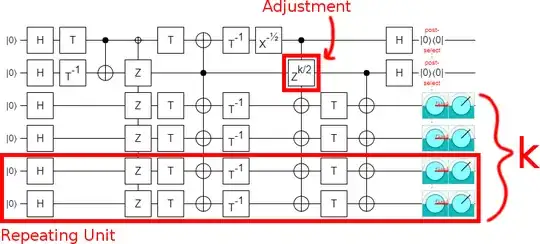The $ [[15,1,3]] $ quantum Reed-Muller code is a CSS code famous for implementing logical $ T $ (strongly) transversally. It has stabilizer generators \begin{align*} XXXXXXXXIIIIIII,&ZZZZZZZZIIIIIII \\ XXXXIIIIXXXXIII,&ZZZZIIIIZZZZIII \\ XXIIXXIIXXIIXXI,&ZZIIZZIIZZIIZZI \\ XIXIXIXIXIXIXIX,&ZIZIZIZIZIZIZIZ \\ &ZZZZIIIIIIIIIII \\ &ZZIIZZIIIIIIIII \\ &ZIZIZIZIIIIIIII \\ &ZZIIIIIIZZIIIII \\ &ZIIIZIIIZIIIZII \\ &ZIZIIIIIZIZIIII \end{align*}
In particular, logical $ T $ is implemented using the physical unitary $$ \bigotimes_{i=1}^{15} T^\dagger $$ How do we know that the $ [[15,1,3]] $ code doesn't have weakly transversal implementations of other gates, for example $ \sqrt{T} $? In other words, is it possible that there is some (weakly) transversal physical gate $$ \bigotimes_{i=1}^{15} g_i $$ which implements logical $ \sqrt{T} $ on the codespace? Here all the $ g_i $ are in $ U(2) $ but they are not all assumed to be equal.
The obvious first place to look is the paper The Smallest Code with Transversal T which claims that the smallest code with transversal $ \sqrt{T} $ is the $ [31,1,3] $ quantum Reed-Muller code.
Although this paper does not assume strong transversality (all the $ g_i $ equal) it assumes something that is perhaps even more restrictive. Namely, "Assumption 2" of the paper is that every $ g_i $ for a transversal implementation of logical $ \sqrt{T} $ must be either the single qubit unitary $ \sqrt{T} $ itself or it must be some power of the single qubit unitary $ \sqrt{T} $.
For definitions of transversal (what I call weakly transversal here for emphasis) and strongly transversal we quote the paper above
"Definition 2: A logical single qubit unitary is implemented in a transversal manner if it is implemented by individual operations on each qubit $i$." So $$ \bigotimes_{i=1}^{n} g_i $$ "Definition 3: We say that a gate is strongly transversal if the operation on each set of identically labelled qubits is the same for each and every label." So $$ \bigotimes_{i=1}^{n} g_i $$ with all the $ g_i $ equal.
